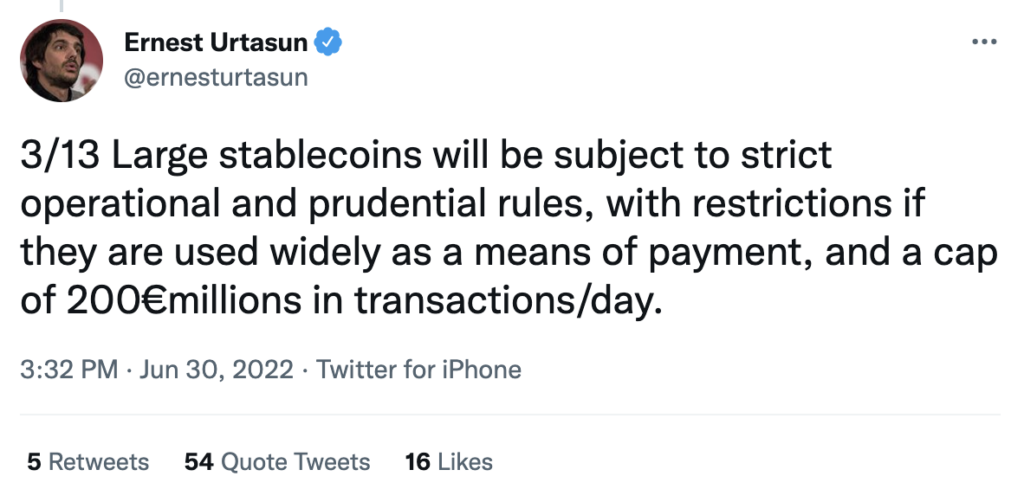On June 30, the European Union recently agreed to some of the most comprehensive cryptocurrency regulations of any jurisdiction globally to date. Over the coming months, EU policymakers will determine exactly how those rules will be implemented and enforced, but overall, the clarity these rules provide for how to operate in one of the world’s biggest markets should be welcome news for the cryptocurrency industry. You can read part one of our breakdown of the proposed new rules to learn about the EU’s new Transfer of Funds Regulation — more commonly known as the Travel Rule in other jurisdictions. In part two below, we explain the other key component of the proposed new regime: the Markets in Crypto Assets (MiCA) regulation, which covers licensing for cryptocurrency businesses operating in the EU.
What is the EU MiCA
The Markets in Crypto Assets (MiCA) regulation will provide a unified licensing regime for the entire EU, meaning cryptocurrency businesses (or CASPs — Crypto-Asset Service Providers — as EU regulators call them) won’t need permission from each individual EU country in order to offer services to their citizens. While we’re still awaiting the finalization and release of all details, industry reports have already described some of the key elements of the deal, which we will discuss here.
First, a few key notes on who MiCA applies to:
- The EU MiCA applies to every cryptocurrency business looking to operate in the EU, regardless of where they’re incorporated. This differentiates the EU’s regulations from those of some other jurisdictions, like the UK, which currently allow cryptocurrency businesses domiciled in other countries to offer services to their residents without a UK-issued license.
- Notably, the EU MiCA does not currently provide regulations for DeFi protocols, though rules for DeFi are expected to be developed in the 18 months following MiCA’s entry into force (anticipated by December 2022 or early 2023).
- MiCA may, however, provide some rules for NFTs and marketplaces that have a higher degree of fungibility because, for example, they are fractional or part of a collection. In such a case, NFT marketplaces (i.e. trading platforms) offering those sorts of NFTs would be required to get authorisation under MiCA.
In addition to requiring that crypto companies follow similar licensing rules to those required of traditional financial intermediaries — fit and proper persons tests, capitalization requirements, and ongoing disclosure requirements — MiCA also places liability on cryptocurrency businesses for customer losses that arise from preventable hacks or operational failures. MiCA also establishes additional rules for specific types of cryptocurrency businesses. We outline the most important parts below.
Stablecoin issuers
Rules for stablecoin issuers, to be overseen by the European Banking Authority, will include a mandatory right of redemption, a physical presence in the EU, and reserve requirements that establish a minimum level of liquidity. There will also be specific rules applied to particular types of stablecoins, including “asset-referenced tokens,” meaning tokens which have as their reference value a basket of either multiple currencies or any other value (fiat, crypto, commodities or a combination of such assets) and “e-money tokens” (single fiat currency-backed tokens).
European Parliament lawmaker Ernest Urtasun tweeted that the agreement will include a strict cap on stablecoin usage.

Source: Twitter
According to Urtasun, “large” stablecoins (it’s still unclear which coins would qualify, though one would expect this includes mainstays like Tether and USDC) will be limited to €200 million worth of transaction volume per day. It’s unclear whether the cap will apply to all transaction activity or just transaction activity related to the EU crypto market in some way, e.g. stablecoin transactions carried out by European residents. Regardless of exactly how it’s enforced, such a cap would drastically change the way stablecoins are used — for context, as of July 1, 2022, Tether’s 24-hour trading volume globally was $53.5 billion.
Market manipulation
The draft text of MiCA also foreshadows some of the world’s first explicit rules to define and ban specific forms of market manipulation in digital assets, though other jurisdictions have argued that bans originally written for other assets like commodities would already apply to digital assets.
Activities that may be captured by MiCA as forms of market abuse could include:
- Insider trading: Using non-public information to gain an advantage in cryptocurrency trading.
- Wash trading: Artificially inflating transaction volume for an asset or marketplace by executing transactions in which the seller is on both sides of the trade, e.g. selling an asset to oneself. We’ve written extensively about wash trading activity in the NFT space.
- Front running: Using advanced knowledge of impending trades to take advantage of price movements that will result from those trades. Some cryptocurrency traders use bots to front-run trades in the milliseconds-long period before they’re confirmed on the blockchain, which is especially problematic on the Ethereum blockchain, where front-running bots can increase their gas spend to ensure their trades are confirmed before trades that have already been submitted by more honest users.
Environmental disclosures
Finally, MiCA calls on cryptocurrency businesses, most notably token issuers, to declare information on their environmental and climate impact. Environmental impact has long been a controversial topic in cryptocurrency, as the Proof of Work (PoW) consensus mechanism of popular blockchains like Bitcoin results in high power usage as miners compete to mine new blocks. Previously, there were rumblings that the EU may ban PoW consensus mechanisms, which would effectively ban the use of Bitcoin and upend the industry entirely. Luckily, that wasn’t the case, although the European Commission may soon be required to develop a report on the environmental impact of cryptoassets and the minimum sustainability standards for consensus mechanisms.
The cryptocurrency industry has new clarity in Europe
The provisional Markets in Crypto Assets (MiCA) regulation, along with the other cryptocurrency rules EU lawmakers have agreed upon, define one of the most comprehensive regimes for digital assets to date. With the clarity this regulatory regime provides, the cryptocurrency industry can confidently pursue its goals of building innovative financial tools, while ensuring the necessary safeguards are in place for sustainable long-term growth. As the details of these crypto regulations are finalized and implemented over the coming months, we look forward to supporting both regulators and industry partners with our best-in-class blockchain investigations and crypto compliance tools.
Still have questions? Read part 1 for a breakdown of the EU’s Transfer of Funds Regulation – also known as “the Travel Rule” – or schedule a chat with us.
This website contains links to third-party sites that are not under the control of Chainalysis, Inc. or its affiliates (collectively “Chainalysis”). Access to such information does not imply association with, endorsement of, approval of, or recommendation by Chainalysis of the site or its operators, and Chainalysis is not responsible for the products, services, or other content hosted therein.
This material is for informational purposes only, and is not intended to provide legal, tax, financial, or investment advice. Recipients should consult their own advisors before making these types of decisions. Chainalysis has no responsibility or liability for any decision made or any other acts or omissions in connection with Recipient’s use of this material.
